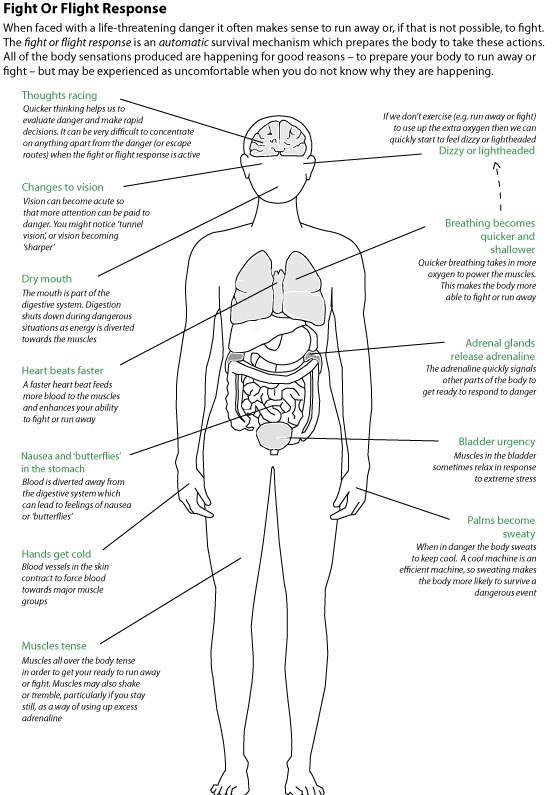Fight Or Flight Response Worksheet
Fight Or Flight Response Worksheet - For example, taking an exam or trying something new for the first time. Think about what happens to your body when you are feeling worried. This helps us to identify situations or events where there might be possible threat or danger. Schauer & elbert (2010) have described an. Web the fight or flight response is a physiological reaction that occurs in response to a perceived harmful event, attack, or threat to survival. Web response to situations we perceive as threatening or stressful. When we need to immobile and numb (adrenaline) Web when there is real, or we believe there is a real, threat or danger, our bodies' automatic survival mechanism kicks in very quickly. Web the fight or flight response is an automatic physiological reaction to an event that is perceived as stressful or frightening. Web here’s what i will cover.
This is the “fight or flight” response. The brain focuses on the perceived danger and. Web there are 3 core parts of the flight or fight anxiety response: Fight, flight or freeze imagine you are in a forest. The “fight or flight” reaction makes our breathing shallow and rapid to increase oxygen, making our bodies ready for action. When we need to immobile and numb (adrenaline) It would be dangerous to react slowly to a threat to our life so our body has an alarm system that automatically gets us ready to react when it senses these signals.
Web this tool enhances your client's understanding of their body's fight or flight response and its impact on their physical and mental health. This helps us to identify situations or events where there might be possible threat or danger. This helps energise us to fight or run away ('fight or flight response'). Think about what happens to your body when you are feeling worried. Happily minding your own business.
Symptoms of fight or flight. How the body prepares to run away or fight when it senses danger. Web the fight or flight response is an automatic physiological reaction to an event that is perceived as stressful or frightening. Like needing to deal with an emergency or before a big performance. Think about what happens to your body when you are feeling worried. This helps energise us to fight or run away ('fight or flight response').
Fight, flight or freeze imagine you are in a forest. Web this tool enhances your client's understanding of their body's fight or flight response and its impact on their physical and mental health. How the body prepares to run away or fight when it senses danger. Web this worksheet will provide information about the fight, flight or freeze response to help clients evaluate which response they are more inclined towards. Schauer & elbert (2010) have described an.
Web this tool enhances your client's understanding of their body's fight or flight response and its impact on their physical and mental health. This helps us to identify situations or events where there might be possible threat or danger. Our brain instantly decides the best way to deal with the perceived threat: Web of “fight or flight” is to use relaxed breathing.
The Worksheet Typically Includes Sections Identifying Personal Triggers That May Activate The Fight Or Flight Response.
Web there are 3 core parts of the flight or fight anxiety response: Web the fight or flight response is an automatic physiological reaction to an event that is perceived as stressful or frightening. When we need to fight our way out of trouble (adrenaline) flight: Web this worksheet will provide information about the fight, flight or freeze response to help clients evaluate which response they are more inclined towards.
Web Fight Or Flight Response Some Of Our Most Basic Emotions Like Fear, Anger Or Disgust Are Signals That Help Our Body Keep Us Safe.
Web flight or fight response. Fight or flight mode on repeat. Schauer & elbert (2010) have described an. Web fight or flight response worksheets.
The Perception Of Threat Or Danger Triggers An Acute Stress Response That Prepares The Body To Fight Or Flee (Flight).
The brain focuses on the perceived danger and. Often this is what we think will happen and how we will be unsuccessful or things will. Web of “fight or flight” is to use relaxed breathing. If we do not use this extra oxygen by running or fighting, there is temporarily an imbalance in the amount of oxygen and carbon dioxide in our blood.
This Helps Energise Us To Fight Or Run Away ('Fight Or Flight Response').
It is extremely helpful for clients to understand the fight or flight response prior to engaging in exposure work for anxiety. This is the “fight or flight” response. The digestive system shuts down to create more. Web flight or fight response.







